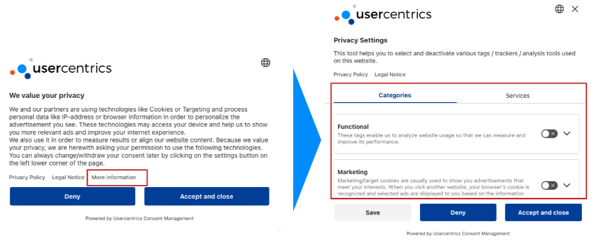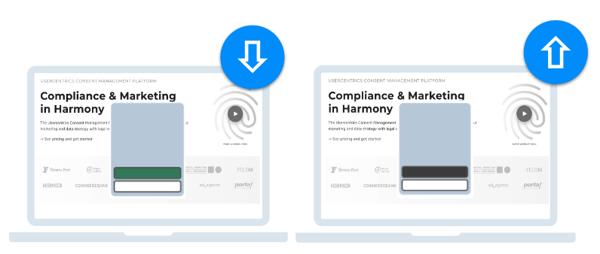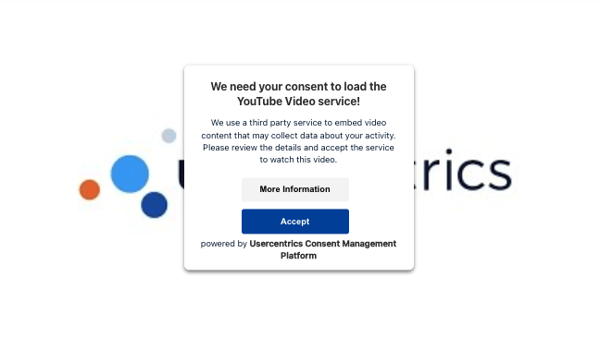April 3, 2024
 by Donna Dror / April 3, 2024
by Donna Dror / April 3, 2024

In the “real” world, people love personalized experiences. It feels great to walk into your favorite coffee shop, where the barista is already pulling a shot for your latte. Or to be recognized at your local pub, corner store, or dog park.
It doesn’t usually feel like that online, though. Why am I getting all these emails? Is my phone spying on me? Our names are the least of what companies know about us.
When I joined the tech industry a decade and a half ago, I was fascinated by the potential of data and its opportunities. Once I understood the significance of protecting user privacy, I was drawn to the idea of how embracing privacy and transparency could significantly benefit businesses.
This led me to join Usercentrics, a leading consent management provider. We help organizations meet data privacy requirements and implement consent-based marketing into their online growth strategies.
Privacy is a fundamental human right, and any successful, data-driven business model in the future must prioritize privacy-compliant data.
All types of personalization require data, as do many other day-to-day functions that we rely on and don’t think much about, especially online. Whether it’s giving our name when ordering our daily latte or accepting cookies on an e-commerce website to enhance our shopping experience.
The personalization of our digital experiences and other uses of our data that we trust and approve of depend on our awareness and consent. These considerations make all the difference in building trust with users.
Online, we create data constantly, and it’s almost always being tracked. But few people know how much data, where that data goes, who gets access to it, or what it’s used for. Trying to hide that info isn’t good business, privacy-compliant, or user-friendly. Smart companies embrace transparency and choice and clearly explain the benefits of consenting to data use for the consumer and the company.
The amount of oversight we have over our personal data varies depending on factors like where we live, which affects which regulations apply to us. There’s also the element of how much we understand the technologies used on websites, apps, and other platforms.
However, the average person shouldn’t have to be a legal or tech expert to have control over who knows about their identity, activities, preferences, families, or jobs.
The perfect privacy experience would center on user privacy from the beginning, long before they ever go to that website or download that game. This concept is called privacy by design. That means that developers create products, services, websites, and apps with privacy as a main consideration, not just an afterthought to mitigate legal risk.
Because we’re talking about the perfect experience – not fine, not good, not great – nothing developers do to amp up privacy will interfere with how users browse, shop, work, or otherwise use the internet. Programmers can respect and enable people to exercise their privacy rights quickly and seamlessly.
But how do they achieve this?
When privacy by design is implemented, consumers visiting websites or using other platforms will
Many websites use small pop-ups called consent banners to inform you about cookies. A consent banner paves the way for this experience, enables compliance with privacy regulations, and helps organizations optimize user consent for the data they need.
Privacy-centered or consent-based marketing makes up another aspect of the perfect privacy experience. It’s already happening in response to several big legal and technical changes, like new privacy regulations and the deprecation of older tracking technologies like third-party cookies. But really, the best reason and biggest driver of the change is that consent- and privacy-based marketing is just better for the bottom line.
Read more: For details on providing the most privacy-compliant and user-friendly consent management experience, check out Optimizing Consent Data and User Trust.
Teams should craft their marketing campaigns with people rather than at people. By learning more detailed information from users, companies can personalize future interactions based on what their clients express interest in and consent to share.
Businesses can then offer tailored communications, discounts, and product deals. That’s the basis of preference management. So, if I only want to hear from a company about a specific service, then that’s the only time I’ll hear from them. No weekly newsletters, no random text messages – just the company delivering what I asked for.
This results in happier customers, visitors, and users. Precision increases engagement by demonstrating respect for preferences and privacy.
Companies waste less of their marketing budget and get better results. Decreasing focus on customer acquisition because of reduced churn also saves money and resources.
In the long term, increasing trust and user engagement leads to higher revenue and improved customer loyalty. Companies know the marketing data they have is of excellent quality, and it works for them to build engagement and enrich lifetime customer value. The perfect privacy experience is a great opportunity for organizations everywhere.
Customer loyalty remains important as an increasing number of data privacy regulations include data portability as a consumer right. This means that consumers have the right to access a copy of the data companies have for them and use it on another platform, even a competitor’s.

Keep up with what’s really going down in marketing with the G2 Tea newsletter. Subscribe here
Relying on customers who cannot leave has never been a great competitive strategy, but even that’s crumbling now as customers exercise more of the rights they’ve been granted. It’s a much more sustainable strategy to make customers so happy they never want to leave.
Privacy laws around the world differ, but many industries employ several of these best practices for long-term success in delivering great privacy experiences.
There are privacy laws all over the world now, plus additional regulations in some regions that include data privacy provisions. Of course, these laws change in various ways, including who needs to comply and when consent is required. This is complex enough for companies to figure out. Consumers shouldn’t be burdened with all the intricacies as well.
Privacy laws typically protect the residents of the region where they’re enacted, so it doesn’t matter where the companies offering goods or services to those people are located, a condition commonly referred to as extraterritoriality.
What does your consent banner need to communicate to visitors outside your region? Can it detect where they’re from? Ideally, it detects location and can automatically adjust the displayed language, legal notifications, and consent information.
of users across sectors only interact with a consent banner’s first layer. The second layer is also legally required by many privacy regulations and is where granular information is usually located.
Source: Usercentrics

Clear and detailed communication: Provide users with the option to access more information in the second layer of your consent banner to enable transparent communication and granular choices.
Privacy regulations usually say that websites can't block users unless they provide a consent choice about cookie use. However, with so many things online that grab their attention, they may click "accept" without thinking. Therefore, it's important to encourage users to focus on what they consent to, even briefly.
Use a consent management platform (CMP) for help. Our research indicated that 99.3% of CMP configurations analyzed (with consent rates over 80%) had the background overlay activated, for example, to cover their website content partially.

A/B testing has shown that establishing a feeling of "being at home" is impactful. By staying true to your company's brand identity and integrating your unique color palette, you can increase the percentage of users interacting with your banner.
The information in the banner’s UI has to be clear and offer valid consent options. Our research found that among those banners with consent rates over 80%, 84% had customized their banner’s first layer messaging.
You can even get more granular with your data privacy and consent strategy by setting up contextual consent, where it’s a relevant option. That means you don’t necessarily ask for blanket consent when visitors arrive at your website.
When the person performs a specific action, like clicking on an embedded YouTube video, you can ask for contextual consent. This involves explaining why you need to collect personal data in order for them to complete the specific action requested.

Respect your users' privacy: Contextual consent ensures that users are fully aware and give explicit permission before a video can load and play.
It makes consent requests for personal data processing more limited and understandable to the average consumer.
Clear language and contextual consent are great for user-friendliness, but that’s just the tip of the iceberg for the perfect privacy experience and privacy compliance.
Nor is it a good way to foster the perfect privacy experience. As noted, the average person online shouldn’t need a law or computer science degree to understand their privacy rights. But they also shouldn’t be limited to a consent banner with one button that only offers “Accept All” as an option.
Limiting people’s options or manipulating them so they only have the choice to do what you want is called using dark patterns. Don’t. Regulatory authorities increasingly frown upon it; it’s already illegal in some jurisdictions, and you will not have happy users or customers when they notice your manipulations.
We build trust when customers feel like they understand their options, when they know we respect their rights, and when they have the power to exercise choices that put them in control.
These are the promises that the perfect privacy experience delivers.
But that experience is never static. Regulations and their requirements are always changing, and digital technologies are always evolving.
Important privacy requirements are also developing from the business side of things. Regulations like the Digital Markets Act (DMA) only directly target a small number of enterprises, but its requirements mean that those companies are requiring their customers – mainly B2B enterprises – to comply as well, which will affect millions of smaller organizations.
Consent requirements, information about data usage, and user rights need to be maintained to make sure people get the right information to freely make informed consent choices. Ideally, for both companies and consumers, much of this online can be automated by CMPs to save time and resources, ensuring the public gets timely, accurate information.

More data, more insights: The ideal consent management platform provides an interaction analytics dashboard with user interaction metrics as a foundation to increase the consent rate.
Clear visual elements are as important as clear language, especially for a first impression. Match the branding of your consent banner to your corporate branding. It’s a way of showing your customers that it’s really “you” asking for consent. Make the buttons and other elements big, bright, and well-labeled to improve user experience and accessibility.
For example, some CMP implementations exclude or hide the “reject” option to manipulate consent rates. However, Usercentrics’ research has found that a banner with the privacy wall style and a “reject” option can have higher consent rates than a banner without.
People change their minds all the time and often have the legal right to do so. Make sure it’s as easy for them to change their consent preferences as it was to give consent in the first place. That’s also a legal requirement under many data privacy laws.
The perfect privacy experience is about good communication and respect. It gives people the best experience rather than doing the bare minimum for compliance. It forces companies to think and build for the future instead of just planning what they can get away with for now. It shows users that you value their privacy and consent.
As you honor customer privacy and focus on great user experience, you become like the barista who recognizes everyone’s face and memorizes everyone’s order. By showing respect for their rights and choices and providing personalized interactions using the data they willingly hand over to you, they walk away happy that you know their names.
This post is part of G2’s Industry Insights series. The views and opinions expressed are those of the author and do not necessarily reflect the official stance of G2 or its staff.
Donna Dror is the CEO at Usercentrics, the global market leader in the Consent and Preference Management space. She has been with the company since January 2022. Donna is Israeli, and has also lived in South Africa and England. She has been in NYC since 2015 but now spends 6 months of the year in Europe, alternating bimonthly among Usercentrics’ offices. Donna has also been an Advisor at Full In Venture Partners, a software-focused early growth investment fund, since May 2019. There, she's been working with a variety of businesses, helping them form functional organizations, processes for scale, GTM strategies, and operational excellence. Fun fact: one of the businesses she advised through Full In was actually Usercentrics! Before joining Usercentrics, Donna was the GM/SVP at Similarweb (NYSE:SMWB). During her 8 years with the company, Donna helped Similarweb grow from $10M ARR to $150M ARR and was also part of the team that took the company public in 2021. Donna is passionate about diversity, equity, inclusion, people management, efficient operational scale, and how technology can drive a positive impact in the world we live in.
For decades, marketers have thrived on a seemingly endless supply of user data. Third-party...
 by Washija Kazim
by Washija Kazim
Today's smartphone-centric world is becoming more familiar with QR codes.
 by Arpith Arun
by Arpith Arun
AI isn’t just creating; it’s collecting.
 by Washija Kazim
by Washija Kazim
For decades, marketers have thrived on a seemingly endless supply of user data. Third-party...
 by Washija Kazim
by Washija Kazim
Today's smartphone-centric world is becoming more familiar with QR codes.
 by Arpith Arun
by Arpith Arun


